
Bristol Harbour
Encyclopedia
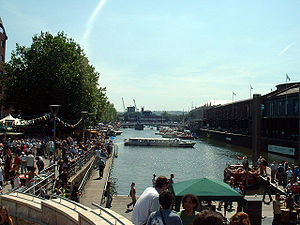
Bristol
Bristol is a city, unitary authority area and ceremonial county in South West England, with an estimated population of 433,100 for the unitary authority in 2009, and a surrounding Larger Urban Zone with an estimated 1,070,000 residents in 2007...
, England. The harbour covers an area of 70 acres (28.3 ha). It has existed since the 13th century but was developed into its current form in the early 19th century by installing lock gates on a tidal
Tidal river
A tidal river is a river, or more typically a stretch of a river, whose flow and level is influenced by tides. An example of a tidal river is the portion of the Connecticut River flowing from Windsor Locks, Connecticut, to the Atlantic Ocean. The Brisbane River, which flows into the Pacific Ocean...
stretch of the River Avon
River Avon, Bristol
The River Avon is an English river in the south west of the country. To distinguish it from a number of other River Avons in Britain, this river is often also known as the Lower Avon or Bristol Avon...
in the centre of the city and providing a tidal by-pass for the river. It is called a floating harbour as the water level remains constant and it is not affected by the state of the tide on the river.
Netham Lock
Netham Lock
Netham lock is the point at Netham in Bristol at which boats from the River Avon, acting as part of the Kennet and Avon Canal, gain access to Bristol's Floating Harbour....
in east Bristol is the upstream limit of the harbour. Beyond the lock is a junction: on one arm the navigable River Avon continues upstream to Bath, and on the other arm is the tidal River Avon. The first 1 miles (1.6 km) of the floating harbour, downstream from Netham Lock, is an artificial channel known as the Feeder Canal
Canal
Canals are man-made channels for water. There are two types of canal:#Waterways: navigable transportation canals used for carrying ships and boats shipping goods and conveying people, further subdivided into two kinds:...
, while the tidal River Avon follows its original route. Between Bristol Temple Meads railway station
Bristol Temple Meads railway station
Bristol Temple Meads railway station is the oldest and largest railway station in Bristol, England. It is an important transport hub for public transport in Bristol, with bus services to various parts of the city and surrounding districts, and a ferry service to the city centre in addition to the...
and Hotwells
Hotwells
Hotwells is a district of the English port city of Bristol. It is located to the south of and below the high ground of Clifton, and directly to the north of the Floating Harbour. The southern entrance to the Avon Gorge, which connects those docks to the sea, lies at the western end of Hotwells. The...
, the harbour and the River Avon run parallel at a distance of no more than 0.65 miles (1 km) apart. At Bristol Temple Meads railway station, the floating harbour occupies the original bed of the River Avon and meanders through Bristol city centre
Bristol city centre
Bristol city centre is the commercial, cultural and business centre of Bristol, England. It is the area south of the central ring road and north of the Floating Harbour, bounded north by St Pauls and Easton, east by Temple Meads and Redcliffe, and west by Clifton and Canon's Marsh...
, Canon's Marsh and Hotwells
Hotwells
Hotwells is a district of the English port city of Bristol. It is located to the south of and below the high ground of Clifton, and directly to the north of the Floating Harbour. The southern entrance to the Avon Gorge, which connects those docks to the sea, lies at the western end of Hotwells. The...
. To the south, the tidal River Avon flows through an artificial channel known as the New Cut
New Cut (Bristol)
The New Cut is an artificial waterway which was constructed between 1804 and 1809 to divert the tidal river Avon through south and east Bristol, England. This was part of the process of constructing Bristol's Floating Harbour, under the supervision of engineer William Jessop...
. This separation of the floating harbour and the tidal River Avon reduces currents and silting in the harbour and prevents flooding. At Hotwells, the floating harbour rejoins the tidal River Avon, via a series of locks, and flows into the Avon Gorge
Avon Gorge
The Avon Gorge is a 1.5-mile long gorge on the River Avon in Bristol, England. The gorge runs south to north through a limestone ridge west of Bristol city centre, and about 3 miles from the mouth of the river at Avonmouth. The gorge forms the boundary between the unitary authorities of...
.
The harbour today
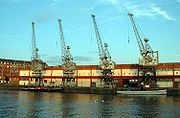
Port of Bristol
The Port of Bristol comprises the commercial, and former commercial, docks situated in and near the city of Bristol in England. The Port of Bristol Authority was the commercial title of the Bristol City, Avonmouth, Portishead and Royal Portbury Docks when they were operated by Bristol City Council,...
, but as ships and their cargo have increased in size, it has now largely been replaced by docks
Dock (maritime)
A dock is a human-made structure or group of structures involved in the handling of boats or ships, usually on or close to a shore.However, the exact meaning varies among different variants of the English language...
at Avonmouth
Avonmouth
Avonmouth is a port and suburb of Bristol, England, located on the Severn Estuary, at the mouth of the River Avon.The council ward of Avonmouth also includes Shirehampton and the western end of Lawrence Weston.- Geography :...
and Portbury
Royal Portbury Dock
The Royal Portbury Dock is part of the Port of Bristol, in England. It is situated near the village of Portbury on the southern side of the mouth of the Avon, where the river joins the Severn estuary — the Avonmouth Docks are on the opposite side of the Avon, within Avonmouth...
. These are located 3 miles (5 km) downstream at the mouth of the River Avon.
The harbour is now a tourist attraction
Tourism
Tourism is travel for recreational, leisure or business purposes. The World Tourism Organization defines tourists as people "traveling to and staying in places outside their usual environment for not more than one consecutive year for leisure, business and other purposes".Tourism has become a...
with museums, galleries, exhibitions, bars
Bar (establishment)
A bar is a business establishment that serves alcoholic drinks — beer, wine, liquor, and cocktails — for consumption on the premises.Bars provide stools or chairs that are placed at tables or counters for their patrons. Some bars have entertainment on a stage, such as a live band, comedians, go-go...
and nightclub
Nightclub
A nightclub is an entertainment venue which usually operates late into the night...
s. Former workshops and warehouse
Warehouse
A warehouse is a commercial building for storage of goods. Warehouses are used by manufacturers, importers, exporters, wholesalers, transport businesses, customs, etc. They are usually large plain buildings in industrial areas of cities and towns. They usually have loading docks to load and unload...
s have now largely been converted or replaced by cultural venues, such as the Arnolfini
Arnolfini
The Arnolfini is an arts centre and gallery in Bristol, England. It has a programme of contemporary art exhibitions, live art, music and dance events, poetry and book readings, talks, lectures and cinema. There is also a specialist art bookshop and a café bar. Educational activities are undertaken...
art gallery, Watershed media and arts centre
Watershed Media Centre
Watershed opened in June 1982 as the United Kingdom's first dedicated media centre. Based in former warehouses on the harbourside at Bristol, it hosts three cinemas, a café/bar, events/conferencing spaces, and office spaces for administrative and creative staff. It occupies the former V and W sheds...
, M Shed
M Shed
The M Shed is a museum in Bristol, England, located on Prince's Wharf beside the Floating Harbour in a dockside transit shed that was previously occupied by the Bristol Industrial Museum...
museum and the At-Bristol
At-Bristol
At-Bristol is a public science and technology "exploration" and education centre and charity in Bristol, England.As a visitor attraction, At-Bristol has hundreds of hands-on exhibits, and a Planetarium with seasonal shows for the over fives, and a 'Little Stars' show for children aged five and under...
science exhibition centre, as well as a number of fashionable apartment buildings. The Bristol Harbour Railway, though organised as part of M Shed, remains in operation, running between the museum and the Create Centre on some bank holidays. Historic boats are permanently berthed in the harbour. These include Isambard Kingdom Brunel
Isambard Kingdom Brunel
Isambard Kingdom Brunel, FRS , was a British civil engineer who built bridges and dockyards including the construction of the first major British railway, the Great Western Railway; a series of steamships, including the first propeller-driven transatlantic steamship; and numerous important bridges...
's , which was the first iron-hulled and propeller
Propeller
A propeller is a type of fan that transmits power by converting rotational motion into thrust. A pressure difference is produced between the forward and rear surfaces of the airfoil-shaped blade, and a fluid is accelerated behind the blade. Propeller dynamics can be modeled by both Bernoulli's...
-driven ocean liner. and a replica
Replica
A replica is a copy closely resembling the original concerning its shape and appearance. An inverted replica complements the original by filling its gaps. It can be a copy used for historical purposes, such as being placed in a museum. Sometimes the original never existed. For example, Difference...
of the Matthew
Matthew (ship)
The Matthew was a caravel sailed by John Cabot in 1497 from Bristol to North America, presumably Newfoundland. After a voyage which had got no further than Iceland, Cabot left again with only one vessel, the Matthew, a small ship , but fast and able. The crew consisted of only 18 people. The...
in which John Cabot
John Cabot
John Cabot was an Italian navigator and explorer whose 1497 discovery of parts of North America is commonly held to have been the first European encounter with the continent of North America since the Norse Vikings in the eleventh century...
sailed to North America in 1497. The historic vessels of M Shed museum, which include the steam tug Mayflower, firefloat Pyronaut and motor tug John King, are periodically operated.
The Bristol Ferry Boat Company and Number Seven Boat Trips operate ferry services in the harbour, serving landing stages close to most of the harbour-side attractions. The later company also operates a Bristol City Council supported commuter service. The Bristol Packet boats offer regular harbour tours with commentaries and river cruises up the River Avon to Conham
Conham
Conham is a suburb of the city of Bristol in England. It lies near Hanham on the north bank of the River Avon just outside the city boundaries in South Gloucestershire....
, Hanham
Hanham
Hanham is a village on the eastern outskirts of Bristol, England, situated on the A431 between Bristol, Bath and Keynsham. It is in the unitary authority of South Gloucestershire. It became a civil parish on April 1, 2003....
and Bath and downstream to Avonmouth
Avonmouth
Avonmouth is a port and suburb of Bristol, England, located on the Severn Estuary, at the mouth of the River Avon.The council ward of Avonmouth also includes Shirehampton and the western end of Lawrence Weston.- Geography :...
. In late July each year, the Bristol Harbour Festival is held, resulting in an influx of boats, including tall ship
Tall ship
A tall ship is a large, traditionally-rigged sailing vessel. Popular modern tall ship rigs include topsail schooners, brigantines, brigs and barques. "Tall Ship" can also be defined more specifically by an organization, such as for a race or festival....
s, Royal Navy
Royal Navy
The Royal Navy is the naval warfare service branch of the British Armed Forces. Founded in the 16th century, it is the oldest service branch and is known as the Senior Service...
vessels and lifeboats
Lifeboat (rescue)
A rescue lifeboat is a boat rescue craft which is used to attend a vessel in distress, or its survivors, to rescue crewmen and passengers. It can be hand pulled, sail powered or powered by an engine...
.
History of Bristol docks
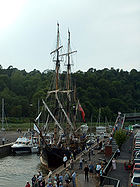
River Frome, Bristol
The River Frome is a river, approximately long, which rises in Dodington Park, South Gloucestershire, and flows in a south westerly direction through Bristol, joining the former course of the river Avon in Bristol's Floating Harbour. The mean flow at Frenchay is The name Frome is shared with...
. Since the 13th century, the rivers have been modified for use as docks including the diversion of the River Frome in the 1240s into an artificial deep channel known as "Saint Augustine's Reach", which flowed into the River Avon. Saint Augustine's Reach became the heart of Bristol's docks with its quays and wharfs. The River Avon within the gorge, and the River Severn
River Severn
The River Severn is the longest river in Great Britain, at about , but the second longest on the British Isles, behind the River Shannon. It rises at an altitude of on Plynlimon, Ceredigion near Llanidloes, Powys, in the Cambrian Mountains of mid Wales...
into which it flows, has tides which fluctuate about 30 feet (9 m) between high and low water. This means that the river is easily navigable at high-tide but reduced to a muddy channel at low tide in which ships would often run aground. Ships had no option but to be stranded in the harbour for unloading, giving rise to the phrase "shipshape and Bristol fashion" to describe how ships and their secured cargo were capable of taking the strain of repeated strandings on the mud.
As early as 1420, vessels from Bristol were regularly travelling to Iceland
Iceland
Iceland , described as the Republic of Iceland, is a Nordic and European island country in the North Atlantic Ocean, on the Mid-Atlantic Ridge. Iceland also refers to the main island of the country, which contains almost all the population and almost all the land area. The country has a population...
and it is speculated that sailors from Bristol had made landfall in the Americas
Americas
The Americas, or America , are lands in the Western hemisphere, also known as the New World. In English, the plural form the Americas is often used to refer to the landmasses of North America and South America with their associated islands and regions, while the singular form America is primarily...
before Christopher Columbus
Christopher Columbus
Christopher Columbus was an explorer, colonizer, and navigator, born in the Republic of Genoa, in northwestern Italy. Under the auspices of the Catholic Monarchs of Spain, he completed four voyages across the Atlantic Ocean that led to general European awareness of the American continents in the...
or John Cabot
John Cabot
John Cabot was an Italian navigator and explorer whose 1497 discovery of parts of North America is commonly held to have been the first European encounter with the continent of North America since the Norse Vikings in the eleventh century...
. After Cabot arrived in Bristol, he proposed a scheme to the king, Henry VII
Henry VII of England
Henry VII was King of England and Lord of Ireland from his seizing the crown on 22 August 1485 until his death on 21 April 1509, as the first monarch of the House of Tudor....
, in which he proposed to reach Asia by sailing west across the north Atlantic. He estimated that this would be shorter and quicker than Columbus' southerly route. The merchants of Bristol, operating under the name of the Society of Merchant Venturers
Society of Merchant Venturers
The Society of Merchant Venturers is a private entrepreneurial and charitable organisation in the English city of Bristol, which dates back to the 13th century...
, agreed to support his scheme. They had sponsored probes into the north Atlantic from the early 1480s, looking for possible trading opportunities. In 1552 Edward VI granted a Royal Charter to the Merchant Venturers to manage the port.
By 1670, the city had 6,000 tons of shipping, of which half was used for importing tobacco
Tobacco
Tobacco is an agricultural product processed from the leaves of plants in the genus Nicotiana. It can be consumed, used as a pesticide and, in the form of nicotine tartrate, used in some medicines...
. By the late 17th century and early 18th century, this shipping was also playing a significant role in the slave trade.
Construction of the floating harbour
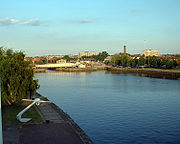
Liverpool
Liverpool is a city and metropolitan borough of Merseyside, England, along the eastern side of the Mersey Estuary. It was founded as a borough in 1207 and was granted city status in 1880...
grew larger and so increased competition with Bristol for the tobacco
Tobacco
Tobacco is an agricultural product processed from the leaves of plants in the genus Nicotiana. It can be consumed, used as a pesticide and, in the form of nicotine tartrate, used in some medicines...
trade. Coastal trade was also important, with the area called "Welsh Back" concentrating on trow
Trow
A trow was a type of cargo boat found in the past on the rivers Severn and Wye in Great Britain and used to transport goods. The mast could be taken down so that the trow could go under bridges, such as the bridge at Worcester and the many bridges up and downstream. The mast was stepped in a three...
s with cargoes from the Slate industry in Wales
Slate industry in Wales
The slate industry in Wales began during the Roman period when slate was used to roof the fort at Segontium, now Caernarfon. The slate industry grew slowly until the early 18th century, then expanded rapidly until the late 19th century, at which time the most important slate producing areas were in...
, stone
Rock (geology)
In geology, rock or stone is a naturally occurring solid aggregate of minerals and/or mineraloids.The Earth's outer solid layer, the lithosphere, is made of rock. In general rocks are of three types, namely, igneous, sedimentary, and metamorphic...
, timber
Timber
Timber may refer to:* Timber, a term common in the United Kingdom and Australia for wood materials * Timber, Oregon, an unincorporated community in the U.S...
and coal
Coal
Coal is a combustible black or brownish-black sedimentary rock usually occurring in rock strata in layers or veins called coal beds or coal seams. The harder forms, such as anthracite coal, can be regarded as metamorphic rock because of later exposure to elevated temperature and pressure...
. The limitations of Bristol's docks were causing problems to business, so in 1802 William Jessop
William Jessop
William Jessop was an English civil engineer, best known for his work on canals, harbours and early railways in the late 18th and early 19th centuries.-Early life:...
proposed installing a dam and lock at Hotwells to create the harbour. The £530,000 scheme was approved by Parliament
Parliament
A parliament is a legislature, especially in those countries whose system of government is based on the Westminster system modeled after that of the United Kingdom. The name is derived from the French , the action of parler : a parlement is a discussion. The term came to mean a meeting at which...
, and construction began in May 1804. The scheme included the construction of the Cumberland Basin
Cumberland Basin (Bristol)
The Cumberland Basin is the main entrance to the docks of the city of Bristol, England. It separates the areas of Hotwells from the tip of Spike Island.The River Avon never flowed through the Cumberland Basin...
, a large wide stretch of the harbour in Hotwells where the Quay walls and bollards have listed building status.
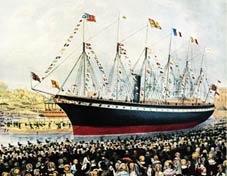
New Cut (Bristol)
The New Cut is an artificial waterway which was constructed between 1804 and 1809 to divert the tidal river Avon through south and east Bristol, England. This was part of the process of constructing Bristol's Floating Harbour, under the supervision of engineer William Jessop...
was constructed from Netham to Hotwells, with another dam installed at this end of the harbour. The Feeder Canal between Temple Meads
Bristol Temple Meads railway station
Bristol Temple Meads railway station is the oldest and largest railway station in Bristol, England. It is an important transport hub for public transport in Bristol, with bus services to various parts of the city and surrounding districts, and a ferry service to the city centre in addition to the...
and Netham provided a link to the tidal river so that boats could continue upstream to Bath. However, the new scheme required a way to equalise the levels inside and outside the Dock for the passage of vessels to and from the Avon, and bridges to cross the water. Jessop built Cumberland Basin with two entrance locks from the tidal Avon, of width 45 ft (13.7 m) and 35 ft (10.7 m), and a 45 feet (13.7 m) wide junction lock between the Basin and what became known as the Floating Harbour. This arrangement provided flexibility of operation with the Basin being used as a lock when there were large numbers of arrivals and sailings. The harbour was officially opened on 1 May 1809.
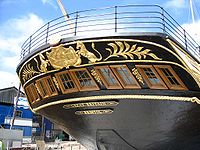
William Patterson (engineer)
William Patterson was a 19th century engineer and boatbuilder.Born in Arbroath, he moved to London where he learned his craft at the yard of William Evans. He then moved to Bristol where he worked for William Scott. When Scott became bankrupt, he took over his yard...
yard within the harbour was used for the construction of many ships notably Brunel's in 1838 and the in 1843. They were some of the largest ships to have been built at the time, and ironically hastened the decline of the city docks by proving the feasibility of large ships. The SS Great Britain was to be towed away from her builders, to have her 1,000 hp
Horsepower
Horsepower is the name of several units of measurement of power. The most common definitions equal between 735.5 and 750 watts.Horsepower was originally defined to compare the output of steam engines with the power of draft horses in continuous operation. The unit was widely adopted to measure the...
engines and interior fitted out on the River Thames
River Thames
The River Thames flows through southern England. It is the longest river entirely in England and the second longest in the United Kingdom. While it is best known because its lower reaches flow through central London, the river flows alongside several other towns and cities, including Oxford,...
, but her 48 ft (14.6 m) beam was too big to pass through the lock. Thus the SS Great Britain was moored in the Floating Harbour until December 1844, before proceeding into Cumberland Basin after coping stones and lock gate platforms were removed from the Junction Lock. At one time there were dozens of Bristol shipyards, the largest in the harbour being Hilhouse
Hilhouse
Hilhouse was a shipbuilder in Bristol, England who built merchantman and men-of-war during the 18th and 19th centuries...
, who became Charles Hill & Sons
Charles Hill & Sons
Charles Hill & Sons was a major shipbuilder based in Bristol, England, during the 19th and 20th centuries. Established in 1845, they specialised mainly in merchant and commercial ships, but also undertook the build of warships and governmental vessels especially during the First and Second World...
in 1845.
19th century improvements
The harbour cost more than anticipated and high rates were levied to repay loans, reducing any benefit the new harbour had at drawing companies back from Liverpool. In 1848 the city council bought the docks company to force down the rates. They employed Isambard Kingdom Brunel to make improvements, including new lock gates, a dredger and sluice gates designed to reduce siltationSiltation
Siltation is the pollution of water by fine particulate terrestrial clastic material, with a particle size dominated by silt or clay. It refers both to the increased concentration of suspended sediments, and to the increased accumulation of fine sediments on bottoms where they are undesirable...
.
By 1867, ships were getting larger and the meanders in the river Avon prevented boats over 300 ft (91 m) from reaching the harbour. A scheme to install a much larger lock at Avonmouth
Avonmouth
Avonmouth is a port and suburb of Bristol, England, located on the Severn Estuary, at the mouth of the River Avon.The council ward of Avonmouth also includes Shirehampton and the western end of Lawrence Weston.- Geography :...
to make the entire river a floating harbour, and to straighten the sharper bends, was dropped after work began on the much cheaper docks at Avonmouth and Portishead
Portishead, Somerset
Portishead is a coastal town on the Severn Estuary within the unitary authority of North Somerset, which falls within the ceremonial county of Somerset England. It has a population of 22,000, an increase of over 3,000 since the 2001 census, with a growth rate of 40 per cent, considerably in excess...
. The present entrance lock was designed by Thomas Howard and opened in July 1873. This has a width of 62 ft (18.9 m) and is the only entrance lock now in use at the City Docks.
From 1893 until 1934 the Clifton Rocks Railway
Clifton Rocks Railway
The Clifton Rocks Railway was an underground funicular railway in Bristol, linking Clifton at the top to Hotwells and Bristol Harbour at the bottom of the Avon Gorge in a tunnel cut through the limestone cliffs. The upper station is close to Brunel's famous Clifton Suspension Bridge and is located...
provided an underground funicular railway
Funicular
A funicular, also known as an inclined plane or cliff railway, is a cable railway in which a cable attached to a pair of tram-like vehicles on rails moves them up and down a steep slope; the ascending and descending vehicles counterbalance each other.-Operation:The basic principle of funicular...
link from the western end of the harbour, which is close to the locks, into Clifton
Clifton, Bristol
Clifton is a suburb of the City of Bristol in England, and the name of both one of the city's thirty-five council wards. The Clifton ward also includes the areas of Cliftonwood and Hotwells...
.
Railways
The original Bristol Harbour Railway was a joint venture by the GWR and the Bristol and Exeter Railway, opened in 1872 between Temple Meads and the Floating Harbour. Its route included a tunnel under St Mary Redcliffe church and a steam-powered bascule bridge over the entrance locks at Bathurst Basin. In 1876 the railway was extended by half a mile to Wapping Wharf. In 1906, new branches from the south via Ashton swing bridge were built to Canons Marsh on the north side of the Floating Harbour and to Wapping via a line alongside the New Cut.Underfall Yard

Sluice
A sluice is a water channel that is controlled at its head by a gate . For example, a millrace is a sluice that channels water toward a water mill...
s and one deep scouring sluice between the harbour and the New Cut, together with a dredging vessel. This drag boat would scrape the silt away from the quay walls. When the deep sluice opened at low tide, a powerful undertow sucked the silt into the river to be carried away on the next tide. The shallow sluices enabled adjustment of the dock water level according to weather conditions.
Several old buildings, which date from the 1880s, remain at Underfall Yard and have listed building status. The octagonal brick
Brick
A brick is a block of ceramic material used in masonry construction, usually laid using various kinds of mortar. It has been regarded as one of the longest lasting and strongest building materials used throughout history.-History:...
and terracotta chimney
Chimney
A chimney is a structure for venting hot flue gases or smoke from a boiler, stove, furnace or fireplace to the outside atmosphere. Chimneys are typically vertical, or as near as possible to vertical, to ensure that the gases flow smoothly, drawing air into the combustion in what is known as the...
of the hydraulic engine house
Hydraulic engine house, Bristol Harbour
The Hydraulic engine house is part of the "Underfall Yard" in Bristol Harbour in Bristol, England.The octagonal brick and terracotta chimney of the engine house dates from 1888, and is grade II* listed, as is the hydraulic engine house itself. It replaced the original pumping house which is now...
dates from 1888, and is grade II* listed, as is the hydraulic engine house itself. It is built of red brick with a slate roof and contains pumping machinery, installed in 1907 by Fullerton, Hodgart and Barclay of Paisley
Paisley
Paisley is the largest town in the historic county of Renfrewshire in the west central Lowlands of Scotland and serves as the administrative centre for the Renfrewshire council area...
, which powers the dock's hydraulic system of cranes, bridges and locks. The former pattern-maker's
Pattern (casting)
In casting, a pattern is a replica of the object to be cast, used to prepare the cavity into which molten material will be poured during the casting process.Patterns used in sand casting may be made of wood, metal, plastics or other materials...
shop and stores date from the same period and are grade II listed, as are the Patent slip and quay walls.
Warehouses
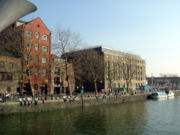
Tobacco
Tobacco is an agricultural product processed from the leaves of plants in the genus Nicotiana. It can be consumed, used as a pesticide and, in the form of nicotine tartrate, used in some medicines...
Warehouse", which was built in 1905 and was the first of the three brick built bonded warehouse
Bonded warehouse
A Bonded warehouse is a building or other secured area in which dutiable goods may be stored, manipulated, or undergo manufacturing operations without payment of duty. It may be managed by the state or by private enterprise. In the latter case a customs bond must be posted with the government...
s in the Cumberland Basin, and is a grade II listed building. B Bond Warehouse
B Bond Warehouse
B Bond Warehouse was a Bonded warehouse serving Bristol Harbour.It dates from 1908. It was designed by the Docks Committee engineer, and built by William Cowlin and Sons. It is made from reinforced concrete, with the ground floor in black brick with a low plinth and patent red bricks, blue...
dates from 1908 and was the first in Britain to use Edmond Coignet's reinforced concrete system. Robinson's Warehouse
Robinson's Warehouse, Bristol
Robinson's Warehouse is a warehouse on Bathurst Parade, on the Floating Harbour in Bristol, England.It was built in 1874 by William Bruce Gingell, and is an example of the Bristol Byzantine style with yellow and red brick and Moorish arches....
built in 1874 by William Bruce Gingell
William Bruce Gingell
William Bruce Gingell was an architect practicing in Bristol.He was in partnership with John Henry Hirst for a time and was influential in the Bristol Byzantine architectural style.- Significant buildings :* Gardiners warehouse...
, and the Granary
Granary, Bristol
The Granary is on Welsh Back, Bristol, England.It was built in 1869 by Archibald Ponton and William Venn Gough with red Cattybrook brick with black and white brick and limestone dressings as a granary but has been used as offices. It is probably the best preserved example of the Bristol Byzantine...
on Welsh Back are examples of the Bristol Byzantine
Bristol Byzantine
Bristol Byzantine is a variety of Byzantine Revival architecture that was popular in the city of Bristol from about 1850 to 1880.Many buildings in the style have been destroyed or demolished, but notable surviving examples include the Colston Hall, the Granary on Welsh Back, the Carriage Works, in...
style with coloured brick and Moorish
Moorish architecture
Moorish architecture is the western term used to describe the articulated Berber-Islamic architecture of North Africa and Al-Andalus.-Characteristic elements:...
arches.
The Arnolfini
Arnolfini
The Arnolfini is an arts centre and gallery in Bristol, England. It has a programme of contemporary art exhibitions, live art, music and dance events, poetry and book readings, talks, lectures and cinema. There is also a specialist art bookshop and a café bar. Educational activities are undertaken...
art gallery occupies Bush House, a 19th century Grade II* listed tea
Tea
Tea is an aromatic beverage prepared by adding cured leaves of the Camellia sinensis plant to hot water. The term also refers to the plant itself. After water, tea is the most widely consumed beverage in the world...
warehouse. and the Watershed Media Centre
Watershed Media Centre
Watershed opened in June 1982 as the United Kingdom's first dedicated media centre. Based in former warehouses on the harbourside at Bristol, it hosts three cinemas, a café/bar, events/conferencing spaces, and office spaces for administrative and creative staff. It occupies the former V and W sheds...
occupies another disused warehouse.
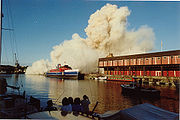
20th century improvements
In 1908, the Royal Edward DockAvonmouth Docks
The Avonmouth Docks are part of the Port of Bristol, in England. They are situated on the northern side of the mouth of the River Avon, opposite the Royal Portbury Dock on the southern side, where the river joins the Severn estuary, within Avonmouth....
was built in Avonmouth
Avonmouth
Avonmouth is a port and suburb of Bristol, England, located on the Severn Estuary, at the mouth of the River Avon.The council ward of Avonmouth also includes Shirehampton and the western end of Lawrence Weston.- Geography :...
and in 1972 the large deep water Royal Portbury Dock
Royal Portbury Dock
The Royal Portbury Dock is part of the Port of Bristol, in England. It is situated near the village of Portbury on the southern side of the mouth of the Avon, where the river joins the Severn estuary — the Avonmouth Docks are on the opposite side of the Avon, within Avonmouth...
was constructed on the opposite side of the mouth of the Avon, making the Bristol City Docks in the floating harbour redundant as a freight dock. In 1977 Charles Hill & Sons, the last shipbuilder at the Albion Yard, closed after delivering the 1541 tonne beer tanker
Tanker (ship)
A tanker is a ship designed to transport liquids in bulk. Major types of tankship include the oil tanker, the chemical tanker, and the liquefied natural gas carrier.-Background:...
Miranda Guiness. Part of the yard reopened in 1980 when Abels Shipbuilders
Abels Shipbuilders
Abels Shipbuilders Ltd is a ship and boat builder in Bristol, England. They are now the largest remaining shipbuilder in Bristol.-Business:...
began operating, who still produce a steady stream of small ferries, survey vessels, tugs and other craft.
Amey Roadstone
Amey plc
Amey plc, previously known as Amey Ltd and Amey Roadstone Construction, is a United Kingdom based infrastructure support service provider. It was once listed on the London Stock Exchange but since 2003 it has been a subsidiary of Spanish company Grupo Ferrovial, S.A....
(formerly T B Brown and Holmes Sand & Gravel) sand dredgers worked from Poole's Wharf in Hotwells
Hotwells
Hotwells is a district of the English port city of Bristol. It is located to the south of and below the high ground of Clifton, and directly to the north of the Floating Harbour. The southern entrance to the Avon Gorge, which connects those docks to the sea, lies at the western end of Hotwells. The...
until 1991. Occasionally coastal trading vessels enter the Cumberland Basin to be loaded with large steel silos manufactured by Braby Ltd at their nearby Ashton Gate works.
The old Junction Lock swing bridge
Swing bridge
A swing bridge is a movable bridge that has as its primary structural support a vertical locating pin and support ring, usually at or near to its centre of gravity, about which the turning span can then pivot horizontally as shown in the animated illustration to the right...
is powered by water pressure from the Underfall Yard hydraulic
Hydraulics
Hydraulics is a topic in applied science and engineering dealing with the mechanical properties of liquids. Fluid mechanics provides the theoretical foundation for hydraulics, which focuses on the engineering uses of fluid properties. In fluid power, hydraulics is used for the generation, control,...
engine house at 750 psi (52 bar). The new Plimsoll Bridge, completed in 1965, has a more modern electro-hydraulic system using oil at a pressure of 4480 psi (309 bar).
Regeneration of the harbourside

Urban renewal
Urban renewal is a program of land redevelopment in areas of moderate to high density urban land use. Renewal has had both successes and failures. Its modern incarnation began in the late 19th century in developed nations and experienced an intense phase in the late 1940s – under the rubric of...
the harbourside.
In 1999, Pero's footbridge
Pero's Bridge
Pero's Bridge is a pedestrian, bascule bridge at St Augustine's Reach in Bristol Harbour. It links Queen Square and Millennium Square.- Structure :...
was constructed, linking the At-Bristol
At-Bristol
At-Bristol is a public science and technology "exploration" and education centre and charity in Bristol, England.As a visitor attraction, At-Bristol has hundreds of hands-on exhibits, and a Planetarium with seasonal shows for the over fives, and a 'Little Stars' show for children aged five and under...
exhibition with Bristol tourist attractions. In 2000, the At-Bristol centre opened on semi-derelict land at Canon's Marsh and some of the existing Grade II listed buildings were refurbished and reused. It was funded with £44.3 million from the National Lottery
National Lottery (United Kingdom)
The National Lottery is the state-franchised national lottery in the United Kingdom and the Isle of Man.It is operated by Camelot Group, to whom the licence was granted in 1994, 2001 and again in 2007. The lottery is regulated by the National Lottery Commission, and was established by the then...
, the Millennium Commission
Millennium Commission
The Millennium Commission in the United Kingdom was set up to aid communities at the end of the 2nd millennium and the start of the 3rd millennium. It used funding raised through the UK National Lottery....
, South West of England Regional Development Agency, and a further £43.4 million from Bristol
Bristol
Bristol is a city, unitary authority area and ceremonial county in South West England, with an estimated population of 433,100 for the unitary authority in 2009, and a surrounding Larger Urban Zone with an estimated 1,070,000 residents in 2007...
city council and commercial partners, including Nestlé
Nestlé
Nestlé S.A. is the world's largest food and nutrition company. Founded and headquartered in Vevey, Switzerland, Nestlé originated in a 1905 merger of the Anglo-Swiss Milk Company, established in 1867 by brothers George Page and Charles Page, and Farine Lactée Henri Nestlé, founded in 1866 by Henri...
. Private investors are also constructing studio apartment
Studio apartment
A studio apartment, also known as a studio flat , efficiency apartment or bachelor/bachelorette style apartment, is a small apartment which combines living room, bedroom, and kitchen or kitchenette into a single room...
buildings.
The regeneration of the Canon's Marsh area is expected to cost £240 million. Crest Nicholson
Crest Nicholson
Crest Nicholson is a British housebuilding company based in Chertsey, Surrey.-History:The Company was founded by Bryan Skinner in 1963 as Crest Homes and floated on the London Stock Exchange in 1968. One of the characteristics that differentiated Crest from most other housebuilders of the time was...
were the lead developers, constructing 450 new flats, homes and waterside offices. It is being carried out under the guidance of The Harbourside Sponsors’ Group, which is a partnership between the City Council, key stakeholders, developers, businesses, operators and funders.
The Cumberland basin is used by a variety of small boats from sailing clubs and is surrounded by tourist attractions. The old hydraulic pumping station has been converted into a public house
Public house
A public house, informally known as a pub, is a drinking establishment fundamental to the culture of Britain, Ireland, Australia and New Zealand. There are approximately 53,500 public houses in the United Kingdom. This number has been declining every year, so that nearly half of the smaller...
and is a Grade II listed building.
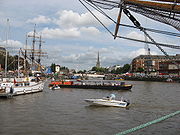
Events
Bristol Harbour hosts the Bristol Harbour FestivalBristol Harbour Festival
The Harbourside in Bristol, England, has hosted the Bristol Harbour Festival for 40 years, with over 250,000 visitors attending live music, street performances and a variety of live entertainment. The festival includes music stages, a dance stage, street theatre performances, and water displays...
in July of each year, attended by tall ship
Tall ship
A tall ship is a large, traditionally-rigged sailing vessel. Popular modern tall ship rigs include topsail schooners, brigantines, brigs and barques. "Tall Ship" can also be defined more specifically by an organization, such as for a race or festival....
s and hundreds of ships and boats of all kinds. About 200,000 visitors view the boats, and watch live music, street performances and other entertainments.
In 1996, the harbour was the setting for the first International Festival of the Sea
International Festival of the Sea, 1996
The International Festival of the Sea, 1996 was a maritime festival, held in and around the Floating Harbour in the English port city of Bristol. Held in 1996, it was the first of a series of International Festivals of the Sea that have since been held in various United Kingdom ports.The key theme...
. A larger version of the annual harbour festivals, this was attended by many tall ships, including the Eye of the Wind
Eye of the Wind
The Eye of the Wind is a ship built in 1911 by C Lühring of Brake, West Germany, originally as a topsail schooner named 'Friedrich'.-History:The 'Friedrich' was initially used as a schooner for the South American hide trade...
, Pride of Baltimore
Pride of Baltimore
The Pride of Baltimore was an authentic reproduction of a 19th-century Baltimore clipper topsail schooner commissioned by citizens of Baltimore, Maryland. It was lost at sea with four of its twelve crew on May 14, 1986...
, Rose, Kaskelot
Kaskelot (tall ship)
Kaskelot is the flagship of the Square Sail fleet and is based out of her homeport of Charlestown, Cornwall, UK . She is a three-masted barque and one of the largest remaining wooden ships in commission. The Kaskelot was built in 1948 by J...
and Earl of Pembroke. The key theme was John Cabot
John Cabot
John Cabot was an Italian navigator and explorer whose 1497 discovery of parts of North America is commonly held to have been the first European encounter with the continent of North America since the Norse Vikings in the eleventh century...
's pioneering voyage of discovery to the Americas
Americas
The Americas, or America , are lands in the Western hemisphere, also known as the New World. In English, the plural form the Americas is often used to refer to the landmasses of North America and South America with their associated islands and regions, while the singular form America is primarily...
and a replica of Cabot's ship, the Matthew
Matthew (ship)
The Matthew was a caravel sailed by John Cabot in 1497 from Bristol to North America, presumably Newfoundland. After a voyage which had got no further than Iceland, Cabot left again with only one vessel, the Matthew, a small ship , but fast and able. The crew consisted of only 18 people. The...
, was dedicated prior to its reenactment of Cabot's voyage the following year. In 2009, the 200th anniversary of the Floating Harbour was commemorated with a series of celebratory events.
See also
- Port of BristolPort of BristolThe Port of Bristol comprises the commercial, and former commercial, docks situated in and near the city of Bristol in England. The Port of Bristol Authority was the commercial title of the Bristol City, Avonmouth, Portishead and Royal Portbury Docks when they were operated by Bristol City Council,...
- Bristol Harbour FestivalBristol Harbour FestivalThe Harbourside in Bristol, England, has hosted the Bristol Harbour Festival for 40 years, with over 250,000 visitors attending live music, street performances and a variety of live entertainment. The festival includes music stages, a dance stage, street theatre performances, and water displays...
- Bristol MarinaBristol MarinaThe Bristol Marina is located in Bristol Harbour, Bristol, England. The marina has been in operation since 1980. It is situated adjacent to the SS Great Britain on the south side of the harbour on the site of the former Charles Hill & Sons Ltd's Albion Dockyard, which it shares with Abels...

